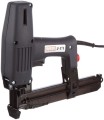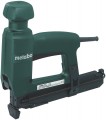Fastener sizes
Standard sizes of fasteners for which the tool is designed. This information is necessary for the correct selection of consumables: each standard dimensions corresponds to certain dimensions of parts, and sometimes also design features. There are a great many standards describing standard sizes; they differ not only in the type of fastener, but also in the geography of application and even by specific manufacturers. Detailed data on various standard sizes can be found in special sources; here we will provide general points on some of the most popular options.
First of all, it is worth saying that the standard dimensions describes only two parameters - thickness and width (for nails - size and width of the head). The length can be different: for example, for the popular staple dimensions 53, the length range can be from 4 to 14 mm, and for 140 - from 6 to 14 mm. At the same time, tools for a certain standard dimensions are not necessarily compatible with all length options. So when assessing compatibility with consumables, you should pay attention not only to this point, but also to the restrictions on the minimum and maximum length of fasteners.
This is what the list of the most popular sizes for rectangular brackets looks like:
- 55. One of the smallest sizes used in modern staplers is 6 mm wide and 1.1 mm thick.
- 90. Another relatively small standard dimensions, it has even a slightly smaller width - 5.8 mm - and a thickness in the...range of 1 - 1.27 mm.
— 57. Staples 10.6 mm wide and 1.2 mm thick.
- 59. The “thin” analogue of dimensions 57, with the same width, provides a thickness of only 0.75 mm.
— 140. Quite rigid staples with a width of 10.6 mm and a thickness of 1.24 mm.
- 114. A slightly enhanced variation of dimensions 57, with increased width and thickness - 10.8 mm and 1.4 - 1.6 mm, respectively.
- 53/53F. Quite wide (11.3 mm) staples, available in both 0.75 mm (53) and 1.25 mm (53F) thicknesses.
— 72. In fact, it’s an analogue of the 53 described above: staples 11.3 mm wide and 0.7 mm thick.
- 54/58. Wide staples 12.8 - 12.9 mm, also available in two thicknesses - 0.75 mm in version 58, 1.25 mm in version 54.
Of the semicircular staples used mainly for fastening cables, the most popular options are:
- S. Relatively small staples with a width of 6.2 mm and a thickness of 1.25.
- L. Larger dimensions - 7.7 mm wide with the same 1.25 mm thickness.
In nails for driving tools, the thickness is indicated by the size, and the width by the largest dimensions of the head. The most popular sizes these days are:
— J. Small fastening nails only 1.2 mm thick with a head width of 2 mm.
— N. Diameter 1.65 mm, cap width 2.8 mm.
- DA. The so-called finishing (finishing) nails are quite large in dimensions: size 1.8 mm, head width 3.5 mm. The head has a characteristic D-shape and, as befits finishing nails, when hammered, it is almost completely recessed into the material.
Regarding pins/studs, it is worth noting that such fasteners are actually nails without heads. Therefore, the main dimensions of such parts is thickness (size), for the most common standard sizes it is as follows:
— 40. Thin pins/studs, only 0.64 mm thick.
— 41. Larger fastener, with a size of 1.2 mm.
Detailed information on choosing a standard dimensions for specific tasks can be found in special sources.
Min. nail diameter
The smallest thickness of nails (see "Type of fastener") that the stapler can work with.
A nail that is too thin is just as undesirable for a tool as one that is too thick: already in the store, such parts can hang out, and there is no question of correct “shooting” at all. Therefore, this limitation should definitely be taken into account when choosing, especially if you plan to work with nails of small thickness. The most "thin" modern staplers have a minimum limit of about 1 mm, and in professional models it can exceed 2.5 mm and even 3 mm.
Max. nail diameter
The largest thickness of nails (see "Type of fastener") that the stapler can work with.
Thick nails require not only the appropriate size of the magazine and feeder, but also significant effort is required to drive them. Therefore, the larger the maximum allowable nail diameter, the more powerful, heavier and more expensive the tool, usually. Professional pneumatic nailers can be compatible with fasteners of 3.5 mm or more, but for entry-level tools, a thickness of 1.2 — 1.5 mm is often more than enough.

